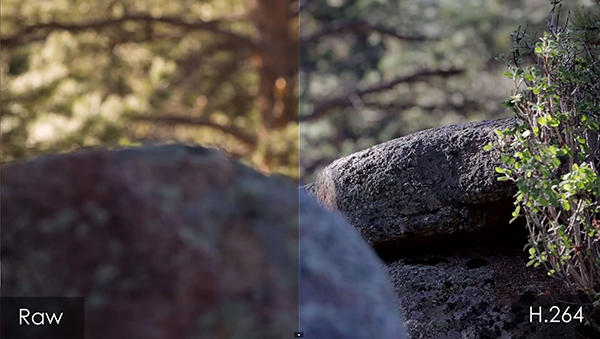
Do you know the technologies of video surveillance, or IP cameras? If you are interested, you may hear about H.264, H.265 and H.266. These two similar concepts are not the same things, but they both are video coding standard.
Let’s compare H.264, H. 265 (HEVC) and H.266.
What is H.265?
H.265 is a new video coding standard developed by ITU-TVCEG after H.264. The H.265 standard revolves around the existing video coding standard H.264, retaining some of the original technologies, while improving some related technologies.
The new technology uses advanced technology to improve the relationship between code stream, encoding quality, delay and algorithm complexity, and achieve optimal settings. Specific research contents include: improving compression efficiency, improving robustness and error recovery capabilities, reducing real-time delay, reducing channel acquisition time and random access delay, and reducing complexity. Due to the optimization of the algorithm, H264 can realize standard-definition digital image transmission at a speed lower than 1Mbps; H265 can realize the transmission of 720P (resolution 1280*720) ordinary high-definition audio and video transmission at a transmission speed of 1~2Mbps.
H.265 is designed to transmit higher-quality network videos under limited bandwidth, and can play videos of the same quality with only half of the original bandwidth. This also means that our smart phones, tablets and other mobile devices will be able to directly play 1080p full HD videos online. The H.265 standard also supports 4K (4096×2160) and 8K (8192×4320) ultra-high-definition video. It can be said that the H.265 standard allows network video to keep up with the “high resolution” of the display screen.

What is H.264?
H.264, which is also the tenth part of MPEG-4, is proposed by the Joint Video Team (JVT), which is formed by the ITU-T Video Coding Expert Group (VCEG) and the ISO/IEC Moving Picture Expert Group (MPEG). The highly compressed digital video codec standard. This standard is usually called H.264/AVC (or AVC/H.264 or H.264/MPEG-4AVC or MPEG-4/H.264 AVC) and clearly states its developers.
The biggest advantage of H.264 is that it has a high data compression ratio. Under the same image quality, the compression ratio of H.264 is more than 2 times that of MPEG-2 and 1.5 to 2 times that of MPEG-4. For example, if the size of the original file is 88GB, it will become 3.5GB after being compressed by the MPEG-2 compression standard, and the compression ratio will be 25:1, while it will become 879MB after being compressed by the H.264 compression standard, from 88GB to 879MB. The compression ratio of H.264 reaches an astonishing 102:1. Low bit rate (Low Bit Rate) plays an important role in the high compression ratio of H.264. Compared with compression technologies such as MPEG-2 and MPEG-4ASP, H.264 compression technology will greatly save users’ download time and Data traffic charges. It is especially worth mentioning that H.264 has a high compression ratio while also having high-quality and smooth images. Because of this, H.264-compressed video data requires less bandwidth during network transmission. It is also more economical.

What is H.266?
In 2020, Fraunhofer HHI officially announced the next-generation video coding and decoding standard H.266/VVC (Versatile Video Coding), which has been supported by industry partners Apple, Ericsson, Intel, Huawei, Microsoft, Qualcomm and Sony. It has been for more than 3 years, mainly for 4K and 8K services.
Similar to when H.265/HEVC came out, H.266 has further optimized the compression method, which can further compress the file size of video resources by up to 50%, while ensuring that the definition of video transmission remains unchanged. To put it simply, a 90-minute UHD 4K video based on H.265 encoding requires 10Gb, while based on H.266 it is only about 5Gb.
It is reported that software that supports H.266/VVC decoding will appear in the second half of this year. At the same time, products that support hard decoding of H.266 video resources may meet with consumers in the near future. Looking back, the evolution of HEVC specifications can be said to be quite slow. The standard was signed in 2013 and only supported by Apple on iOS 11 in 2017. Today, H.264/AVC still occupies the mainstream. Some industry video experts pointed out that H.266/VCC is expected to be widely accepted and used around 2027.
In addition, for the prosperity of the global video industry, the MPEG organization is also promoting H.266/VVC and two derivative standards MPEG-5 Part 1 (EVC) and MPEG-5 Part 2 (LCEVC). According to a test conducted by the United Kingdom, VVC has a clear advantage compared to the free competitive standard AV1.
What is the difference between H.265, H.264 and H.266?
Compared with H.264/AVC, H.265/HEVC provides more different tools to reduce the bit rate, in terms of coding units, the smallest 8×8 to the largest 64×64. Areas with little information (the color change is not obvious, such as the red part of the car body and the gray part of the ground) are divided into larger macroblocks, and the codewords after encoding are less, while the areas with more details (tires) are divided into macroblocks. The blocks are correspondingly smaller and larger, and there are more codewords after encoding, which is equivalent to focusing on the image, thereby reducing the overall code rate and improving the coding efficiency accordingly. At the same time, the H.265 intra prediction mode supports 33 directions (H.264 only supports 8), and provides better motion compensation processing and vector prediction methods.
Repeated quality comparison tests have shown that under the same image quality, compared with H.264, the size of the video stream encoded by H.265 is about 39-44% less than H.264. Due to different quality control methods, this data will change accordingly. The data obtained through subjective visual testing shows that when the bit rate is reduced by 51-74%, the quality of H.265 encoded video can be similar to or better than that of H.264 encoded video, which is essentially better than expected The signal-to-noise ratio (PSNR) is better. The evaluation criteria of these subjective visual tests cover many disciplines, including psychology and human visual characteristics. The video samples are very extensive. Although they cannot be used as final conclusions, they are also very encouraging results.

The current HEVC standard has three modes: Main, Main10 and Main Still Picture. Main mode supports 8bit color depth (that is, each of the red, green, and blue colors has 256 chromaticities, a total of 16.7 million colors), Main10 mode supports 10bit color depth, which will be used on Ultra High Definition TV (UHDTV). The first two restrict the chroma sampling format to 4:2:0. It is expected that the standard will be expanded in 2014 to support 4:2:2 and 4:4:4 sampling formats (that is, providing higher color reproduction) and multi-view coding (such as 3D stereo video coding).
In fact, the H.265 and H.264 standards have some overlap in various functions. For example, the Hi10P part of the H.264 standard supports 10-bit color depth video. On the other hand, the part of H.264 (Hi444PP) can also support 4:4:4 chroma sampling and 14-bit depth. In this case, the difference between H.265 and H.264 is that the former can use less bandwidth to provide the same function, and the price is the computing power of the device: H.265 encoded video requires more computing power to decode. At present, a chip supporting H.265 decoding has been released-Broadcom of the United States (Broadcom) released a Brahma BCM 7445 chip at the CES exhibition in early January of this year, which is a quad-core processor using a 28-nanometer process , Can simultaneously transcode four 1080P video data streams or analyze H.265 encoded ultra-high-definition video with a resolution of 4096×2160.
The birth of the H.265 standard is to transmit higher-quality network video under limited bandwidth. For most professionals, the H.265 coding standard is not unfamiliar. It is a video coding standard developed by ITU-TVCEG after H.264. The H.265 standard mainly revolves around the existing video coding standard H.264. In addition to retaining some of the original technologies, it adds the ability to improve the relationship between code stream, coding quality, delay and algorithm complexity, etc. Related technologies. The main content of H.265 research includes improving compression efficiency, improving robustness and error recovery capabilities, reducing real-time delay, reducing channel acquisition time and random access delay, and reducing complexity.
So, what is the new of H.266?
(1) Division structure
H.265 is a quadtree division, H.266 is a quadtree plus a trinomial tree and a binary tree division, so there will be many rectangular blocks in the H.266 division. H.266 also adopted the I frame, allowing independent division of luminance and chrominance
(2) Loop filter
The adaptive loop filter (ALF) has been added to H.266.
(3) Intra prediction
PDPC is added to H.266;
The LM prediction model was added to H.266, but only the LM model was accepted this time. Considering the complexity of MMLM and MFLM, we are still conservative;
H.266 only uses the adjacent reconstructed pixels on the long side to calculate the average for the DC mode, while the adjacent pixels on the long side and the short side in 265 calculate the average;
Wide-angle intra prediction technology is adopted in H.266;
Multi-reference line intra prediction technology is adopted in H.266.
(4) Inter-frame prediction
H.266 has newly added affine, mode AMVR technology and ATMVP technology.
(5) Transformation
AMT technology has been newly added to H.266.
(6) Current image reference (added to BMS)
Brand-new technology, that is, find the most similar block of the current block to be coded in a large range of the current frame, calculate an MV, and transmit this MV during encoding;
(7) DMVR, motion vector derivation at the decoding end

Summary
H.266 is the newest technology, but it is not completely used. As the H.265 is the most popular technology, we will still use it for a long time. The H.264 may be replaced in the future.
If you have different opinion, welcome to leave your comment.
Related Topics:
Buyer Guide: Hikvision IP Cameras vs. Dahua IP Cameras
What is the Development of Video Surveillance System?
How many Types of the Video Conference System? Which one can Enterprises Choose?
6 Solutions of Video Surveillance Transmission
Video Surveillance Devices: DVR vs. NVR vs. XVR
What is the Video surveillance system? Four things you need to know!





